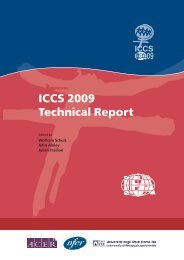Teacher Education and Development Study in Mathematics - IEA
Teacher Education and Development Study in Mathematics - IEA
Teacher Education and Development Study in Mathematics - IEA
You also want an ePaper? Increase the reach of your titles
YUMPU automatically turns print PDFs into web optimized ePapers that Google loves.
134<br />
TEACHER PAY AND STUDENT MATHEMATICS ACHIEVEMENT<br />
Philipp<strong>in</strong>es<br />
Composition of the teacher labor force<br />
Total primary <strong>and</strong> secondary school enrollments <strong>in</strong> the Philipp<strong>in</strong>es reached 12.1 million<br />
<strong>and</strong> 5.0 million dur<strong>in</strong>g 2003 <strong>and</strong> 2004 respectively. The correspond<strong>in</strong>g numbers of<br />
public primary <strong>and</strong> secondary school teachers numbered 337,597 <strong>and</strong> 120,685, with an<br />
additional 70,066 teachers <strong>in</strong> private <strong>in</strong>stitutions (Department of <strong>Education</strong>, 2009). In<br />
1991, almost all teachers <strong>in</strong> basic education were female, but by 2004 the proportions of<br />
female primary <strong>and</strong> secondary school teachers had dropped to just over 89% <strong>and</strong> just<br />
under 76% respectively.<br />
Accord<strong>in</strong>g to the Bureau of Labor <strong>and</strong> Employment Statistics (BLES) (2003), the size of<br />
the teacher labor force has been relatively stable <strong>in</strong> recent years, with a net <strong>in</strong>crease of<br />
approximately 70,000 teachers from 1991 to 2000. With more than 35,000 new teacher<br />
education graduates over each year of this period, <strong>and</strong> a slight, concurrent <strong>in</strong>crease<br />
<strong>in</strong> the student–teacher ratio (BLES, 2003), one might assume a substantial surplus of<br />
primary <strong>and</strong> secondary school teachers. In fact, estimates suggest that around 30% of<br />
teacher education degree-holders work outside of teach<strong>in</strong>g (BLES, 2003).<br />
In 1997, the Commission on Higher <strong>Education</strong> noted that about 25% of high school<br />
students who had passed the national college entrance exam<strong>in</strong>ation wanted to become<br />
teachers, <strong>and</strong> that about 71% of teacher education program entrants actually completed<br />
their degrees (Agarao-Fern<strong>and</strong>ez & Guzman, 2005). Also, about two-thirds of entrants<br />
at the time studied to become primary school teachers, while the other third entered<br />
secondary school teach<strong>in</strong>g programs. S<strong>in</strong>ce the 1970s, the teach<strong>in</strong>g profession has<br />
become associated with relatively low earn<strong>in</strong>gs <strong>and</strong> social status, <strong>and</strong> teacher education<br />
programs are consequently thought to attract academically weaker students (Agarao-<br />
Fern<strong>and</strong>ez & Guzman, 2005; Bautista, 2003).<br />
Because of the social <strong>and</strong> economic disadvantages associated with the teach<strong>in</strong>g<br />
profession, some commentators posit that many <strong>in</strong>dividuals with teach<strong>in</strong>g degrees are<br />
reluctant to enter teach<strong>in</strong>g (see, for example, Agarao-Fern<strong>and</strong>ez & Guzman, 2005).<br />
Although the Philipp<strong>in</strong>es has a relatively old teach<strong>in</strong>g force, with 43% of primary<br />
school teachers 50 years of age or over <strong>and</strong> nearly 127,000 primary <strong>and</strong> secondary<br />
school teachers possibly retir<strong>in</strong>g <strong>in</strong> the next few years, the school system may still have<br />
difficulty attract<strong>in</strong>g a sufficient number of qualified teachers to fill those places (Agarao-<br />
Fern<strong>and</strong>ez & Guzman, 2005; UNESCO Institute for Statistics, 2006).<br />
<strong>Mathematics</strong> education <strong>and</strong> science education, for example, have been served<br />
particularly poorly <strong>in</strong> recent years, ma<strong>in</strong>ly because of significant shortages of qualified<br />
teachers. The most recently available data suggest that only about 1.5% of secondary<br />
education degree holders have science or mathematics as their majors (Agarao-Fern<strong>and</strong>ez<br />
& Guzman, 2005). The current pool of physics <strong>and</strong> chemistry teachers <strong>in</strong> particular<br />
possesses few <strong>in</strong>dividuals who majored <strong>in</strong> physics or chemistry; as a consequence, these<br />
subjects tend to be taught <strong>in</strong> a rote or bor<strong>in</strong>g manner (Somerset <strong>and</strong> colleagues, cited <strong>in</strong><br />
Agarao-Fern<strong>and</strong>ez & Guzman, 2005). Rather than experienc<strong>in</strong>g an <strong>in</strong>tegrated program<br />
for science <strong>in</strong>struction, the few students who want to become physics teachers usually<br />
enroll <strong>in</strong> the regular college physics sequence <strong>and</strong> add on general teach<strong>in</strong>g methods<br />
courses (van den Berg, Locaylocay, & Gallos, 2006). Many mathematics teachers who are<br />
graduates of non-education degree programs that <strong>in</strong>clude at least five college subjects

















